Skeeter Skelton once wrote that the only way to improve upon the Smith & Wesson Model 24 .44 Special would be to make it in stainless steel. Soon after, S&W presented the Model 624, a .44 Special N-frame made from stainless instead of carbon steel. I happened to have read Skeeter’s words a few days prior to walking into a local gun store that had a 624 in their used gun display. It had the 4-inch barrel (6.5-inches was an option) and was wearing Pachmayr rubber grips. The price was right with no box or papers and I became the new owner of my first .44 Special.
S&W Model 624 .44 Special
After I cleaned and lubricated the 624, I called El Paso Saddlery and ordered one of their Model 1920 Threepersons crossdraw holsters with a thumb snap. This was the holster Skeeter wrote often about and when it arrived, I carried the S&W in front of my left hip as I walked my parents’ wooded property in middle Wisconsin.
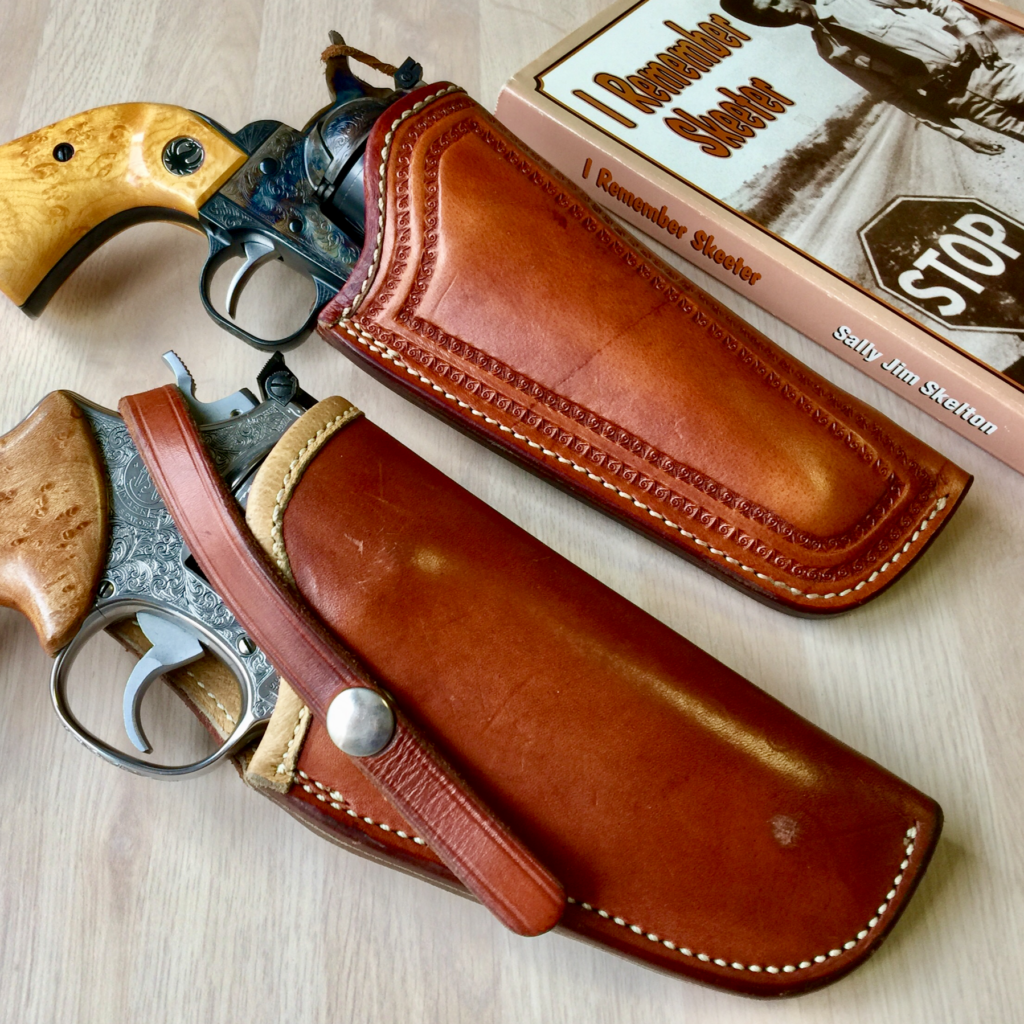
The Pachmayrs absorbed recoil well, but the whole point of the .44 Special over the .44 Magnum is that you can handload it so it won’t pound your hand with recoil. I spread my right hand out on a piece of blank paper and outlined it like a kid at grade school making a turkey card for Thanksgiving. I sent that tracing along with a check to Bear Hug Grips. I requested the Skeeter Skelton style for the square butt N-frame. Skeeter favored walnut or mesquite and had several handles for his revolvers made by Deacon Deason of Bear Hug Grips. I was (and still am) partial to birdseye maple so that was the wood I requested. More than six months later my Dad asked me if I had received my new handles yet. When I told my father that I not yet received the grips, he joked, “What is he doing, growing the tree?” When they finally arrived, we were both impressed. The birdseye maple handles fit me perfectly and their appearance was stunningly handsome. They pointed naturally and gave me excellent trigger control.
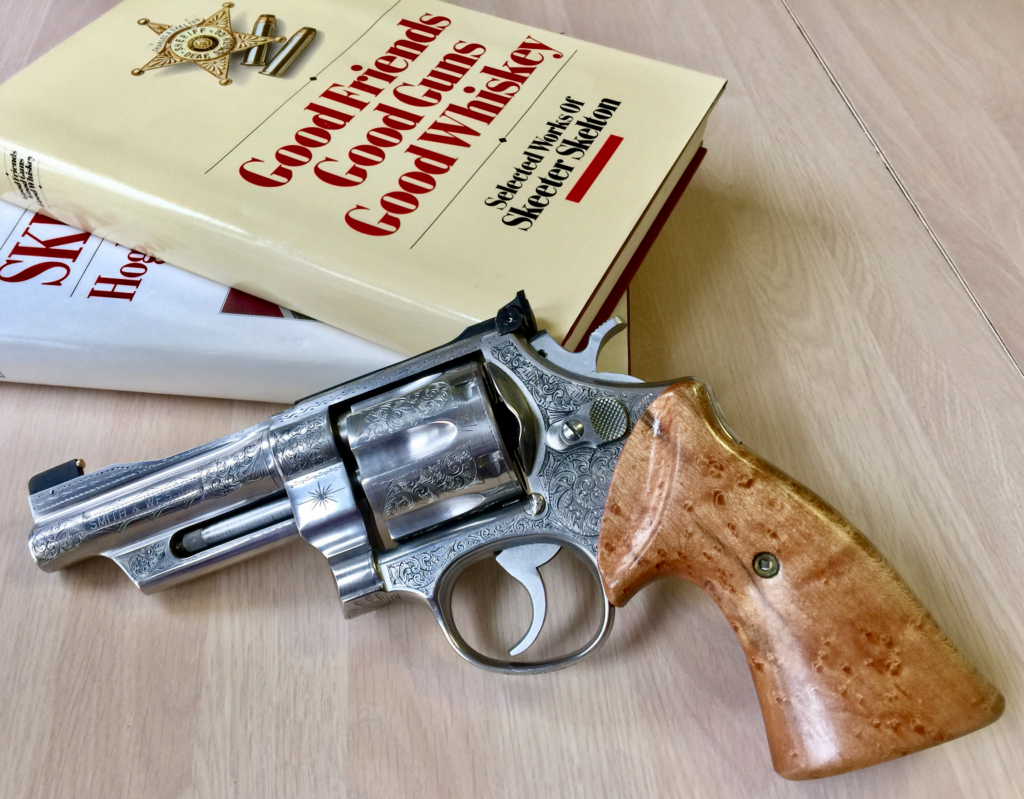
The 4-inch Model 624 (and it’s blued steel brother, the Model 24) feature a “pencil” thin barrel. It still has the underlug to protect the ejection rod, but its barrel’s thinner profile lightens the gun for carry. The .44 caliber hole in the middle helps lighten it as well, compared to a .357 version of the same size, as do the .44 caliber cylinder bores. S&W later came out with “Mountain Gun” versions of this N-frame in .45 Colt and .44 Magnum, utilizing the thin barrel.
S&W target sights work well from the factory, but I added a gold bead front sight and a Weigand Combat rear sight. The classic gold bead picks up light and was the ultimate combat sight a hundred years ago before fiber optics came to provide a modern version. Ed McGivern used gold beads on his revolvers in the 1920s and 30s when he set all kinds of speed and accuracy records. I like its “old school” looks just as much its function. The Weigand rear sight swaps out the blade on the factory iron sight and gives a wider notch that my eyes appreciate. Shooting this gun with slower cowboy action loads is a pleasure. It’s entertaining on steel targets when using Skeeter’s mid-power reloads. It’s quite a powerful handful when packing six rounds of Elmer Keith’s 250-grain hard cast lead bullets with 17.0 grains of 2400 behind it (Elmer went with 17.5, but I dial it back a smidgeon because my Lee Progressive 1000 reloading press’ powder disk isn’t that precise).
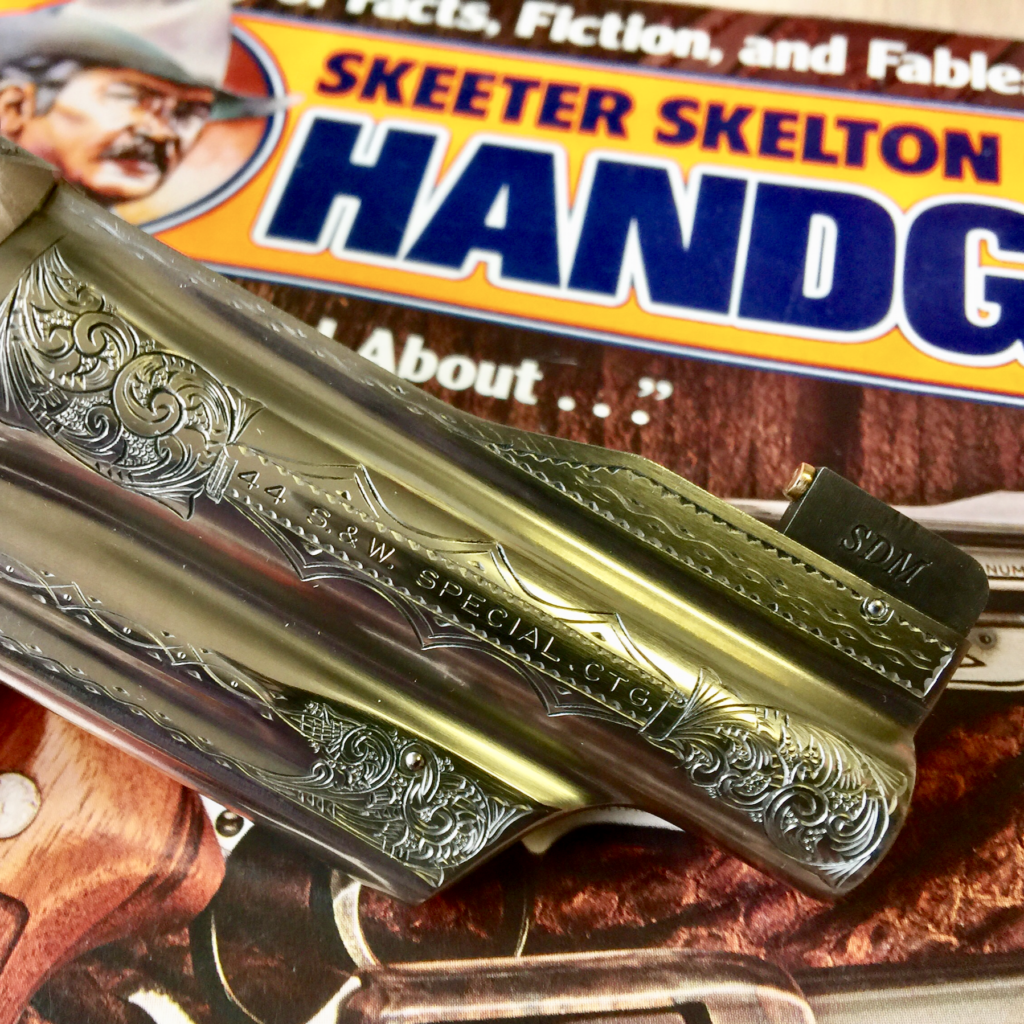
There really isn’t any task that this revolver can’t perform. Target shooting, hunting (Skeeter used to say that downloading the .44 Special was useful for taking rabbits with headshots and that hot loads were suitable for boar or deer), and self-protection are all in the .44 Special’s wheel gun wheelhouse. My dad was an amateur basement gunsmith and he worked over the action for me. The double action is smooth and right around 11 pounds. The single action breaks clean with no over travel at 3 pounds of index finger pressure.
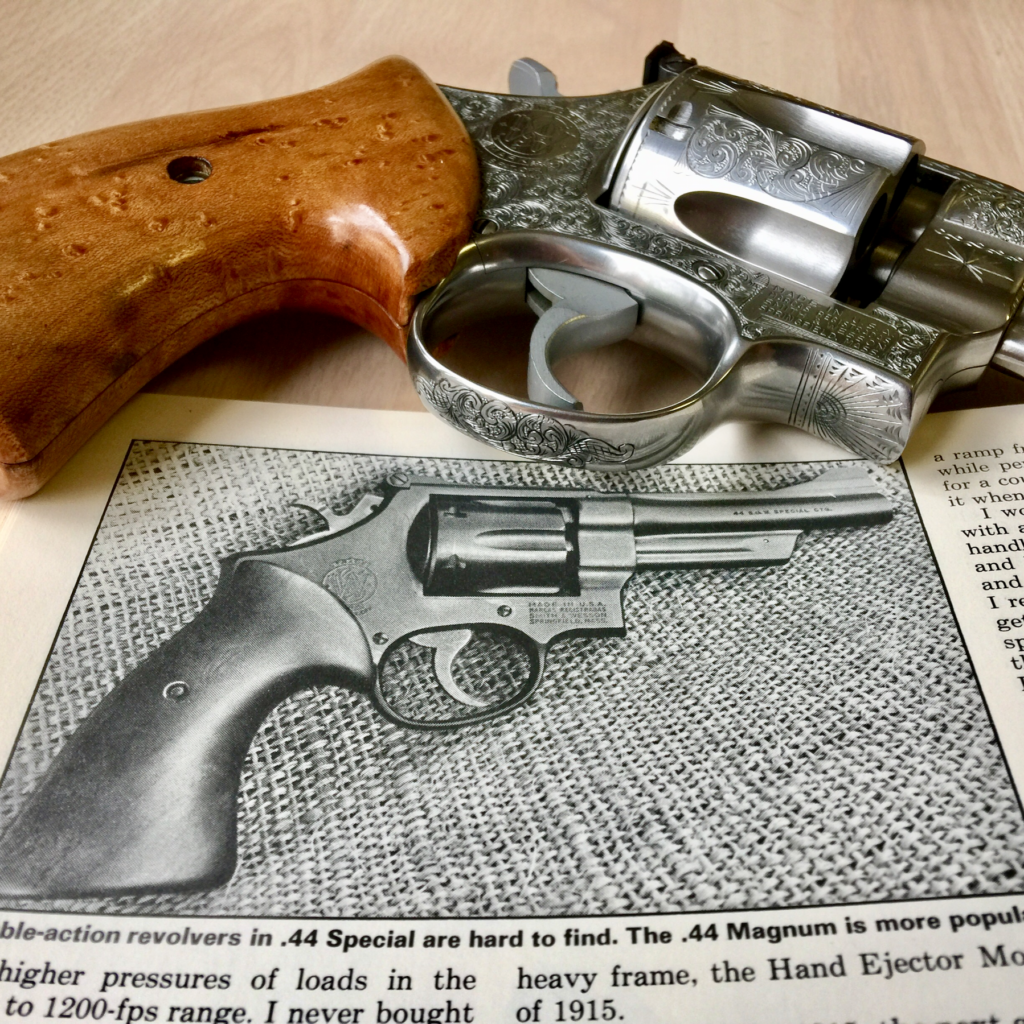
I was feeling nostalgic about Skeeter Skelton, who had passed away in 1988 – a few years before I bought my used 624. I’ve always liked the looks of engraved firearms if they were well done. Not all engraving is to my taste and I’ve found 100% coverage to be too much oftentimes. I like a little free space to show some bluing or in the case of my .44, some open polished stainless steel. Originally this revolver was matte stainless, but I used some Flitz to brighten its surface.
After quite a bit of research I had sent another revolver to Michael Gouse (www.gousefreelancefirearmsengraving.com) and I was superbly pleased with his artistic quality, turnaround time, and pricing. I sent my 624 to him for 75% coverage American scroll. And I sent him a picture of Skeeter Skelton’s cattle brand, a Bar-T logo inside a circle. I asked for this logo to be engraved on the backstrap.
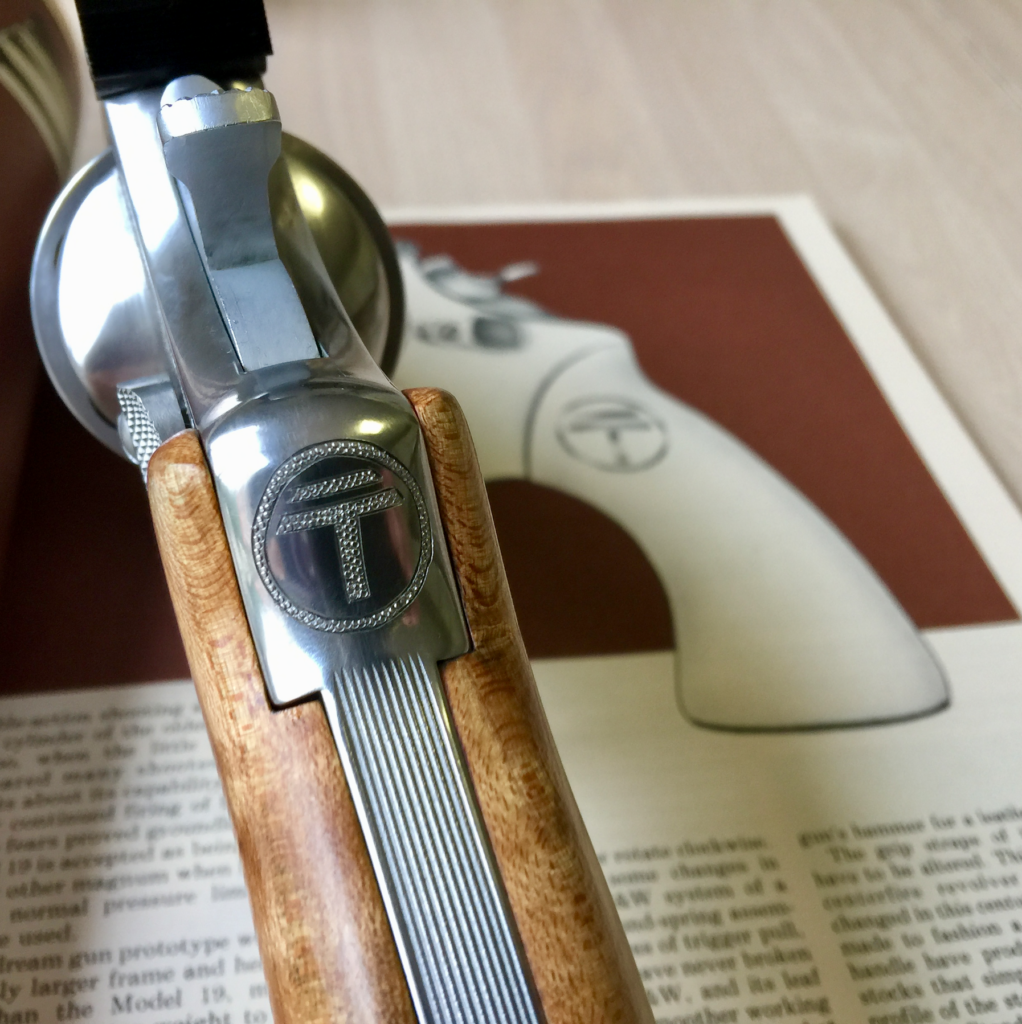
A couple months later the 624 arrived back at my front door and I was beyond pleased with the result. I now had a .44 Special tribute to Skeeter Skelton that I was proud to shoot and show. I continued to carry it for years in its El Paso crossdraw holster.
Ruger Blackhawk Lipseys Exclusive .44 Special
In 2009, firearms distributor Lipseys contracted with Ruger to produce 1000 Blackhawk single action revolvers in .44 Special (500 with 4 5/8” barrels and 500 with 5 ½” barrels). Skeeter Skelton had lobbied Bill Ruger for decades to produce the Blackhawk in .44 Special instead of in its standard chambering of .44 Magnum. Ruger continued to tell Skeeter that there was no business sense in a .44 Special since the cartridge could simply be fired out of the .44 Magnum sixgun instead. But Skeeter’s point was that in real world carry on your hip all day, the slightly less weight of the shorter .44 Special cylinder made a real difference. Skelton had to have gunsmiths create .44 Special Blackhawks from .357 Magnum versions on a custom basis and many of his readers followed suit.
William Ruger passed away in 2002, so he didn’t get to see that Skeeter turned out to be right. The Lipseys exclusive .44 Specials sold out in a few weeks. Many .44 Special fans couldn’t believe Skeeter’s take on the Blackhawk was had finally come true. Some even obtained lightweight aluminum grip frames to swap out to make the gun even lighter. Their popularity with those who appreciate the .44 Special led to Ruger offering Vaquero and Bisley versions over the last several years, not to forget mentioning the GP100 double action .44 Special revolvers of 2017. The following for the .44 Special appears as solid as a lead ingot bar today. Skeeter would be proud.
Of course, I had to have one and I got lucky obtaining a new 4 5/8” barrel Blackhawk. Before I fired it, I installed a Wolff spring kit, which is easy for anyone with a quality screwdriver that won’t bugger up your new gun’s grip frame screws. These springs lighten the hammer pull and the trigger pull. They slick up the action without ever taking a stone to any internal parts. The trigger breaks right around 3 pounds and its crispness and lack of over travel allows consistency when rounds are fired downrange. The Blackhawk’s sights are perfect for me, just as they came from the factory, so they remain unchanged.
I found a grip maker online who carved custom birdseye maple handles for Rugers that included factory medallions. Unfortunately he is no longer in business, which makes me even happier that I ordered the handles when I did. They fit perfectly and include an aluminum spacer that is placed between the grip panels over the screw. It prevents the screw from being over tightened and cracking the wood handles. The attention to detail on these handles includes polishing the end of the screw. Who does that these days? The handles are a deep gold color and the little birdseyes in the wood are three dimensional.
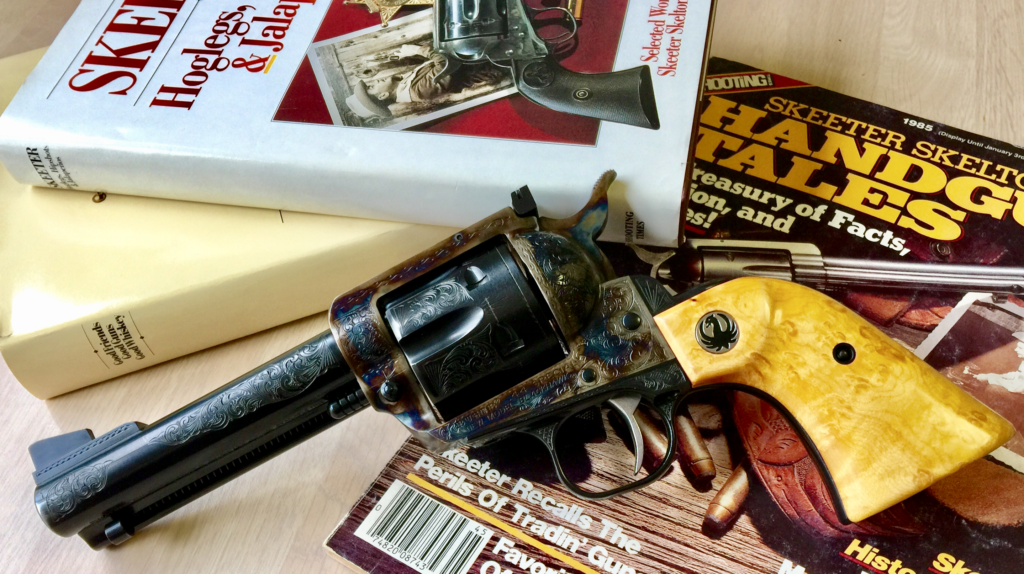
Ruger very wisely moved the ugly “Warning: Before shooting gun…stupid lawyer words” from the side of the barrel to the underside where it all but disappears from view. Of course, this lends the revolver toward engraving much more than if it had that horribly hideous wording roll marked on its side. I made a phone call to Michael Gouse again. I asked if he remembered my 624 from a few years prior and he said that he certainly did. I sent my new Ruger off to Montana with another copy of Skeeter’s Bar-T cattle brand and Gouse returned it to me engraved with 75% coverage American Scroll, the Bar-T engraved on the back strap and a perfect .44 Special matched Ruger to accompany my S&W 624. Two of Skeeter Skelton’s favorite revolvers now made up my personal tribute to the former law enforcer and writer.
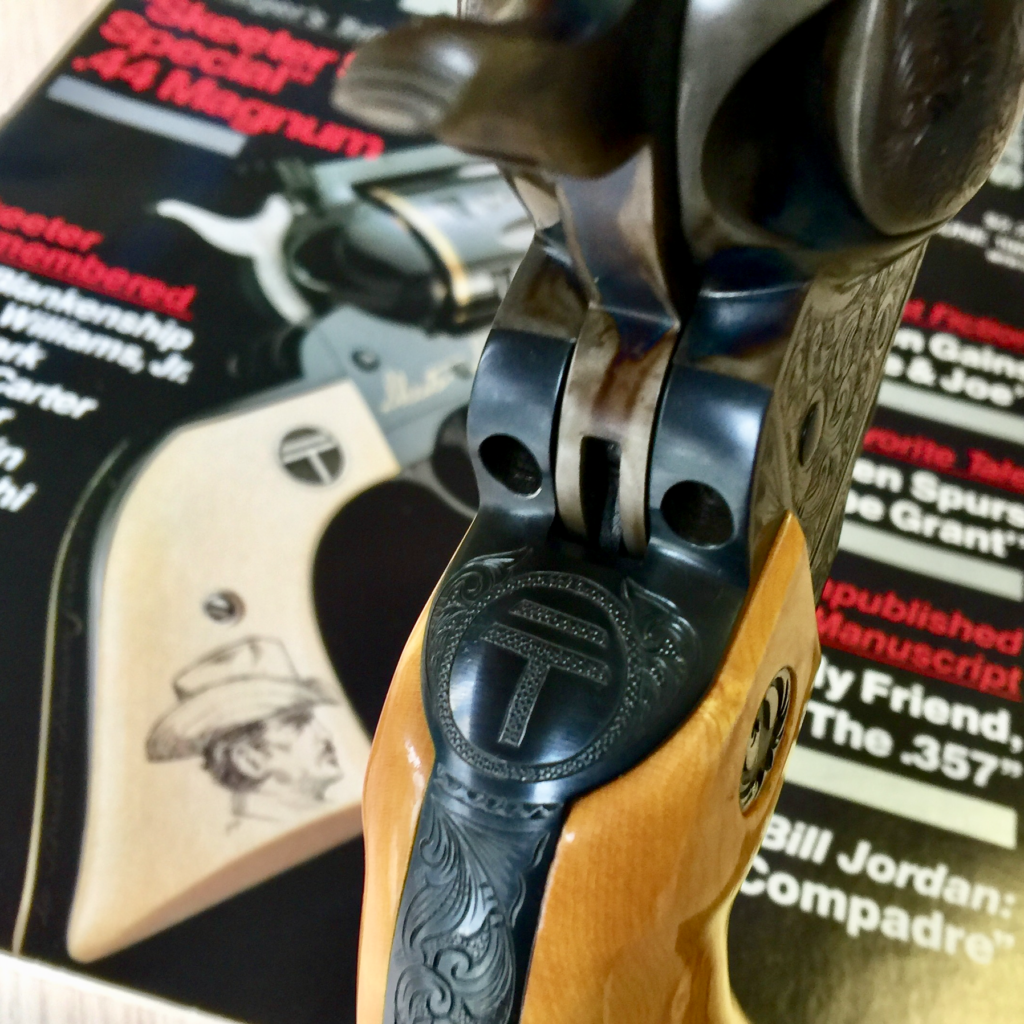
But as handsome as Ruger’s blued finish is on their revolvers, single actions just don’t look “right” to my eye in all blue. The frame needs to be case hardened. This protective hardening of the frame (and oftentimes hammer and/or trigger) is a proprietary heating and quenching process that creates a mottled coloring of blues and oranges and purples and browns and other colors in a random pattern. Original Colt Single Action Army revolvers were finished this way and I’ve always liked the bold smattering of colors.
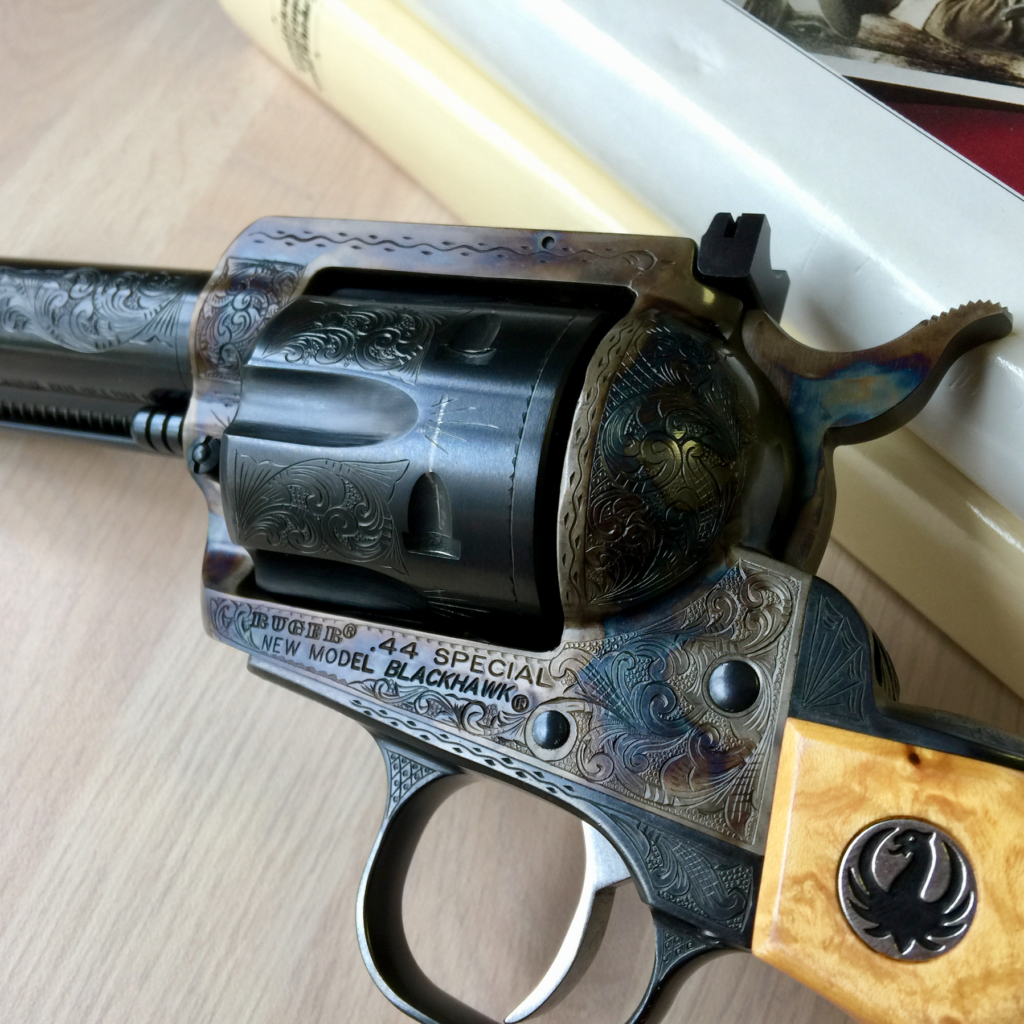
Turnbull Restoration (www.turnbullrestoration.com) is known today for its high quality and original style case hardening process. I shipped my Ruger Blackhawk off to them and it was returned with its frame and hammer imbued with a handsome case hardened finish on its frame and hammer (the trigger is stainless steel and Turnbull’s finish is for carbon steel only).
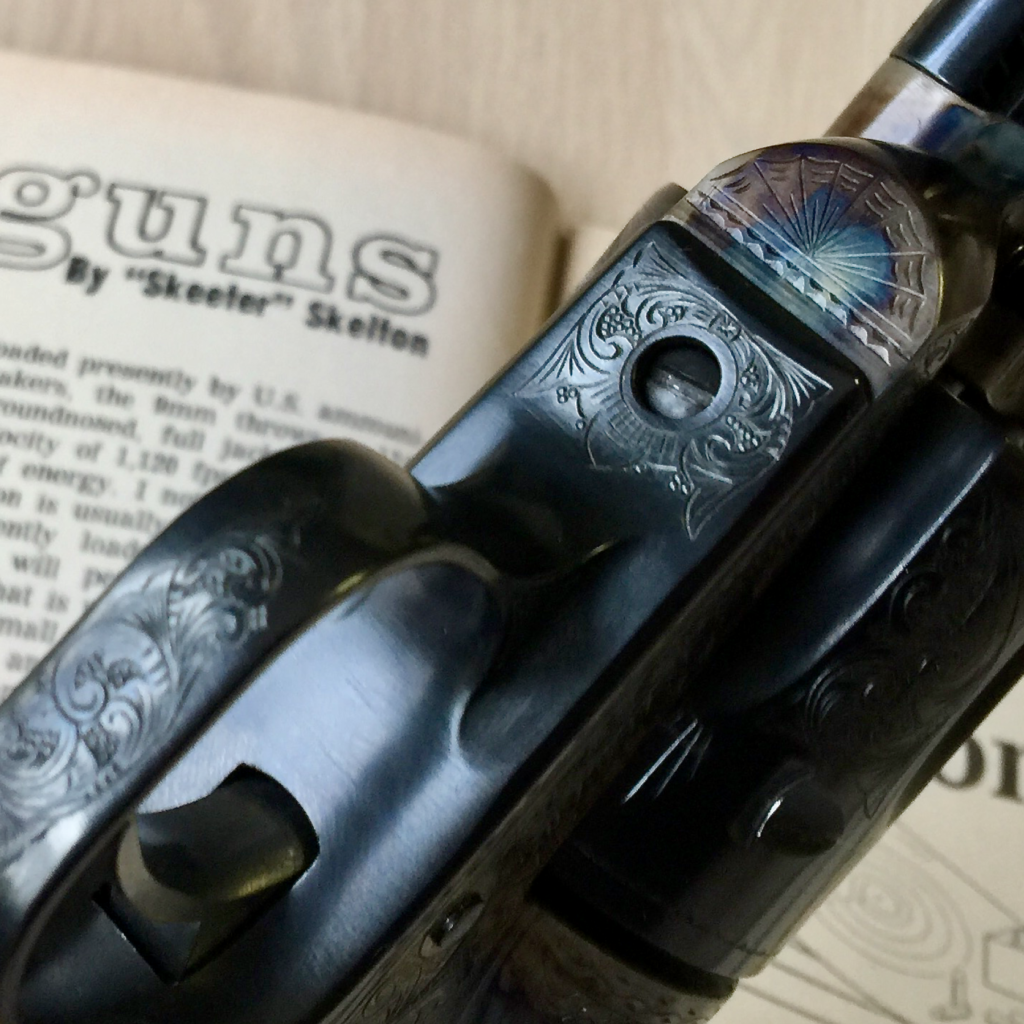
Presentation Case
A search on Ebay found a 1950s silverware box in good shape, large enough to hold both of my tribute revolvers, and a rather inexpensive cost of $50. I sanded the outside and finished it with a few coats of Linspeed oil (sanding in between after each coat had dried). I tore out the insides that were made to hold forks and spoons and replaced it with a half inch thick board cut to fit just inside the lower portion. I outlined the S&W and Ruger .44 revolvers and then used a coping saw to cut out their shapes. Six .44 caliber holes were drilled to position six rounds of .44 Special ammunition as well. Then the wood was covered loosely with blue material and stapled to the back. The inside of the lid was also covered in the same blue material and a sketch of Skeeter holding a revolver at his typewriter was mounted inside the lid. A drawer under the guns was also refinished and lined in blue cloth.

Skeeter’s Article
My Skeeter Skelton tribute was complete. Well, I thought it was complete until an auction on Ebay came up for one last item. When Skeeter Skelton passed in 1988, his family had some medical bills left to pay. Shooting Times magazine had many of Skelton’s original, hand written (on yellow legal paper) article submissions. He wrote for many magazines over the years, but Shooting Times was his long time home. They auctioned off his original articles with a Certificate of Authenticity signed by Skelton’s wife Sally. They were gone pretty before anyone besides those in the industry even knew that had come up for sale. But then one appeared on Ebay out of the blue, 25 years later. And it wasn’t one of Skeeter’s “Me and Joe” tales that always brought a warm smile when reading them. It wasn’t a Dobe Grant article about the hard scrabbled fictitious gunman. It wasn’t a hilariously written poke at firearms newbies like the character Jug Johnson. This article wasn’t a gun review of the untold number that Skeeter Skelton wrote about.
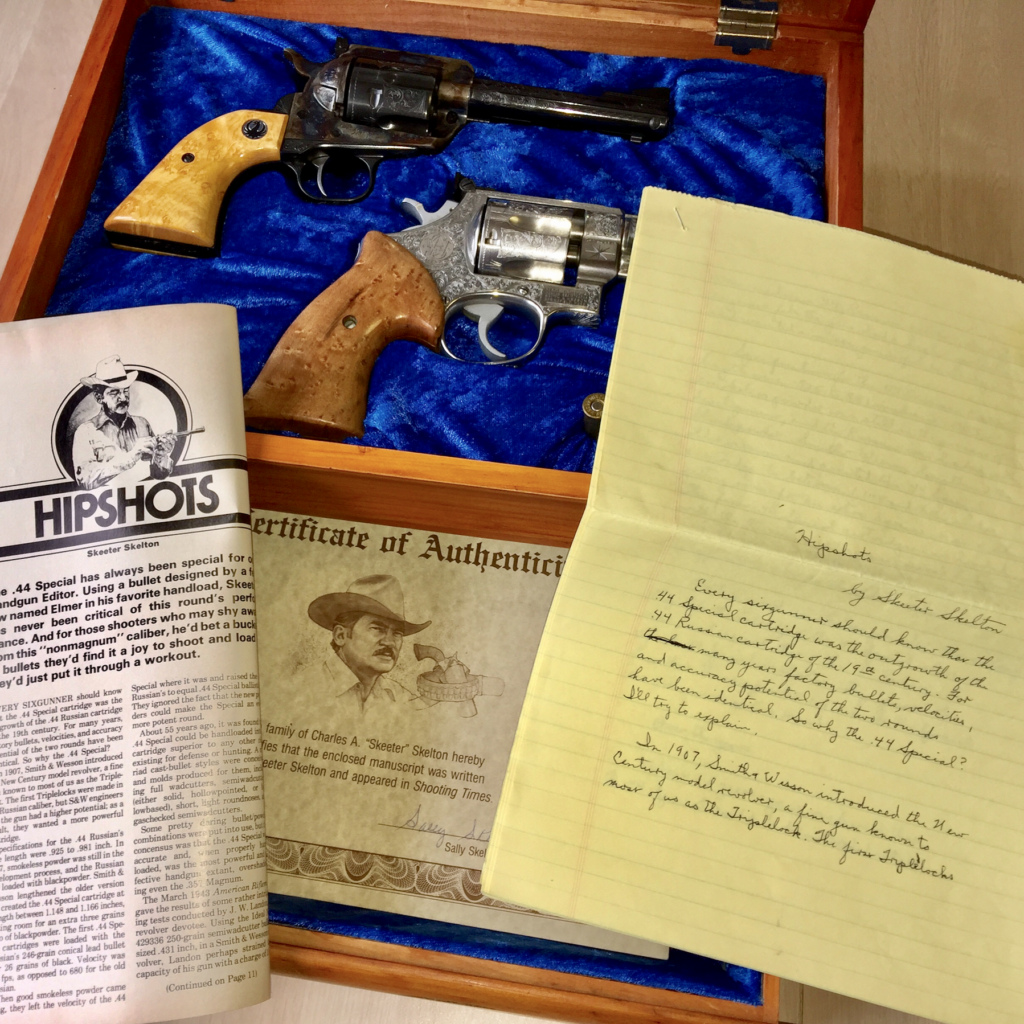
It was about the .44 Special cartridge and it was published in the October 1981 issue of Shooting Times (I obtained a copy of the actual magazine and it’s in the drawer as well!). I am overcome with an inner solemnness of respect when I hold and read Skelton’s handwritten manuscript. It is interesting to note that his words were not edited from his yellow legal pad to the printed magazine page. They didn’t need editing for spelling or grammar, nor content. Skeeter wrote well and he wrote from the heart. He wrote about things that we gun owners liked reading about. If you haven’t read his works, many articles are available online and his books and magazine compilations pop up for sale every once in awhile.

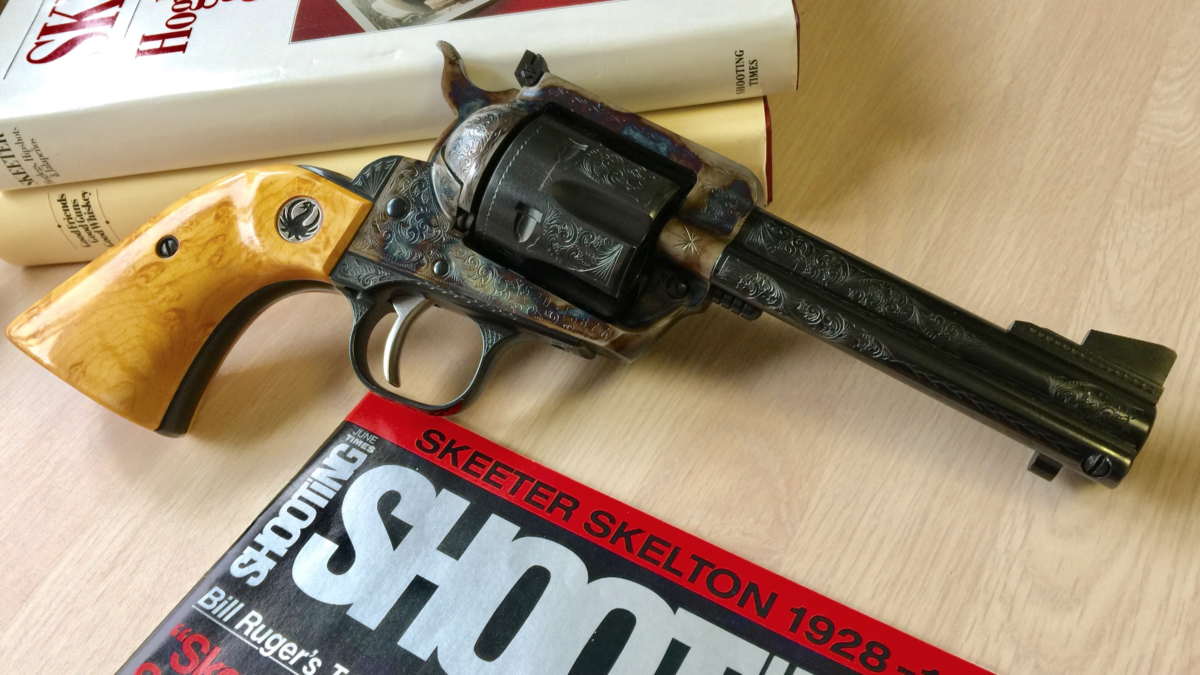
Good Lord, Steve! I’m speechless!
What a beautiful and superbly executed project! I’ve never seen anything like it, and doubt we’ll ever see anything to top it here on RG, unless you’ve got more aces up your sleeve.
The guns, of course, are stunning, but it’s the heartfelt attention you paid to the history and legacy that really turned them into the jewels they are. Well done Sir, well done.
I’d like to point out that I have a new favorite quote from the pages of RevolverGuy:
“Warning: Before shooting gun…stupid lawyer words”
I’ll be chuckling all day over that!
What a wonderful piece. I’m glad it’s Justin’s turn to do the next article, because I wouldn’t want to follow it. Thank you!
Mike
Thanks Mike! By the way, just so our readers know, I do shoot them both often! Here’s a link to a video of me shooting the 624 on steel when I borrowed a friend’s baseball cap mounted video camera:
https://www.youtube.com/watch?v=eplWptt1ngQ
Wow! What Mike said. This was simply epic, Steve!
We’ve been blessed with any number of terrific gun writers over the years. But Skeeter was in a class of his own. His musings on the art of the gun were timeless. Somewhere, he’s sitting around a campfire, wrinkled tin cup with a couple fingers of good whiskey at hand, smiling at what you’ve done.
And to imagine… of all the hand-written stories you might have come across, it was _that_ one. I love everything you did here – the guns, the grips, the holsters, the words. But in my wildest dreams I’d never have imagined that I’d take a few sheafs of old yellow legal paper over such fine, iconic weapons.
Truly extraordinary…
Thanks Jeff! The handwritten article on the .44 Special made me feel the same way…”not in my wildest dreams.” I was at the Shootist’s Holiday this past June and Terry Murbach held the manuscript in his hands. He didn’t quite realize what it was as I began to explain and then it hit him…hard. He was friends with Skeeter and holding that yellow, lined legal paper in his hands brought tears to his eyes. He actually dropped a tear on the first page. So now I’ve got Murbach’s DNA too, makes it worth even more right? Ha! Thanks for reading Jeff!
Wow. Gorgeous guns, great job with the presentation case, and I love that you managed to find both manuscript and print copies of a relevant article. While I buy my guns to shoot, you have inspired me to put together some sort of a display as well!
Thanks Rileyguy! I buy mine to shoot too, but I’ve gotta keep ’em somewhere and sometimes a neat old repurposed cigar box works too! Thanks for reading!
Very nice.
I grew up reading Skeeter’s articles. He was truly a talented writer from an era that will never return. Somewhere, I’m sure he’s sitting in front of a nice campfire nodding his approval.
I think you’re right Jim. Both that Skeeter was brimming with talent and that he’s sitting in front of an eternal campfire telling tales.
I too have a lot of love for Skeeter and his various works. In addition to the 2 books I found a love of the 44 special due to his works. Because of Skeeter and John Taffin I have 5 s&W 44 specials; a 5″ Wolf & Klahr, a 3.5″ Wolf and Klahr (cut down from its original 6.5″), a 6.5″ 2nd model HE, and 1950 Military 4″, and a 4″ Blue 24. I bought the Ruger 44 special Bisley flat-top with a 5.5″ as well. If you reload there isn’t a much more versatile revolver cartridge. I mostly baby the 44 specials with the “Skeeter” load or lighter with the exception of the Ruger, it has had many “Keith” loads through it. My favorite revolver cartridge hands down. Great article.
Mike
Thanks Mike! That John Taffin is doing a fine job of keeping the .44 Special alive isn’t he? I bet your 5″ Wolf & Klahr is pretty sharp!
Steve, this is among the best articles I’ve ever read. Absolutely fantastic work!
Simply outstanding!
Jim H.